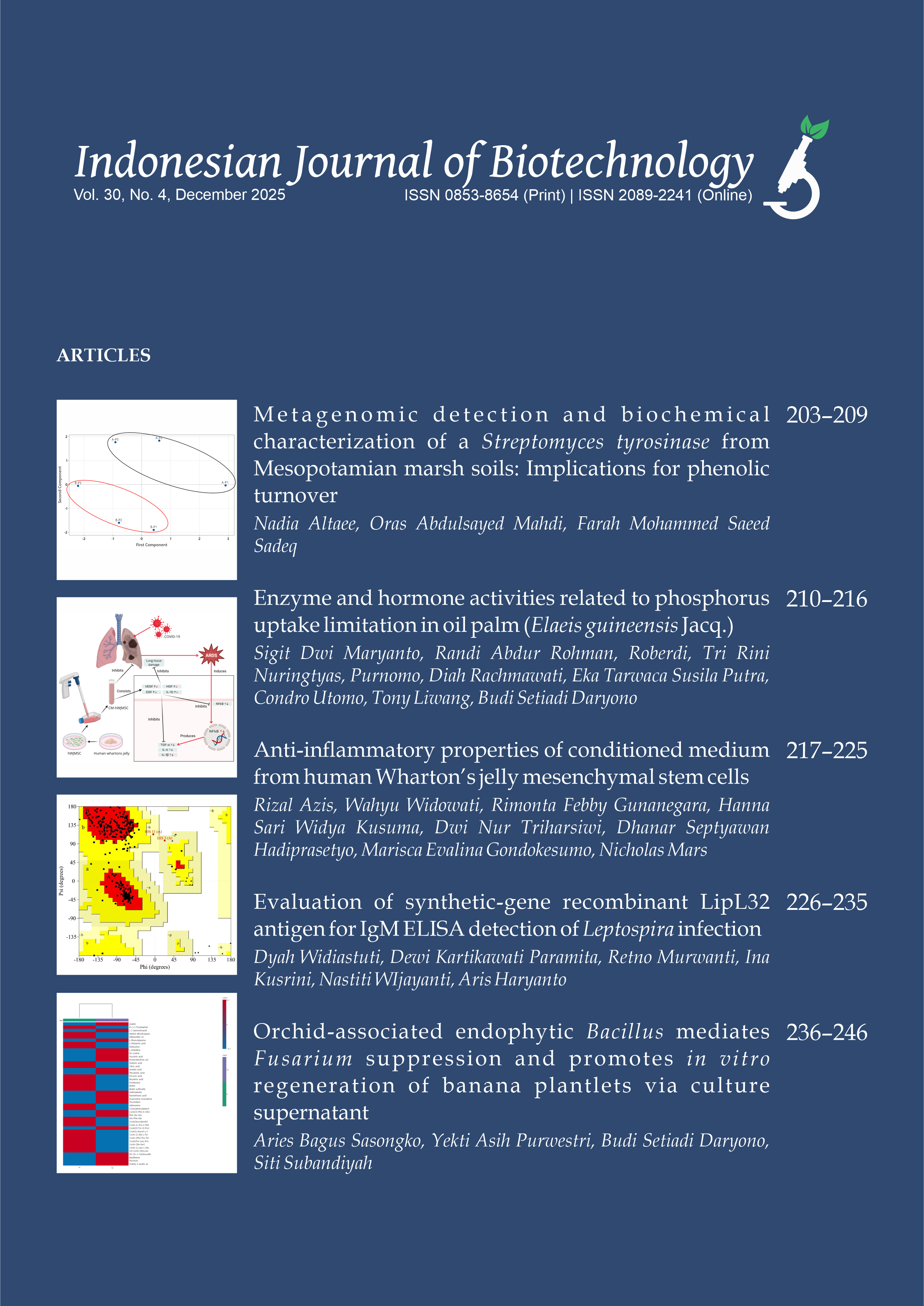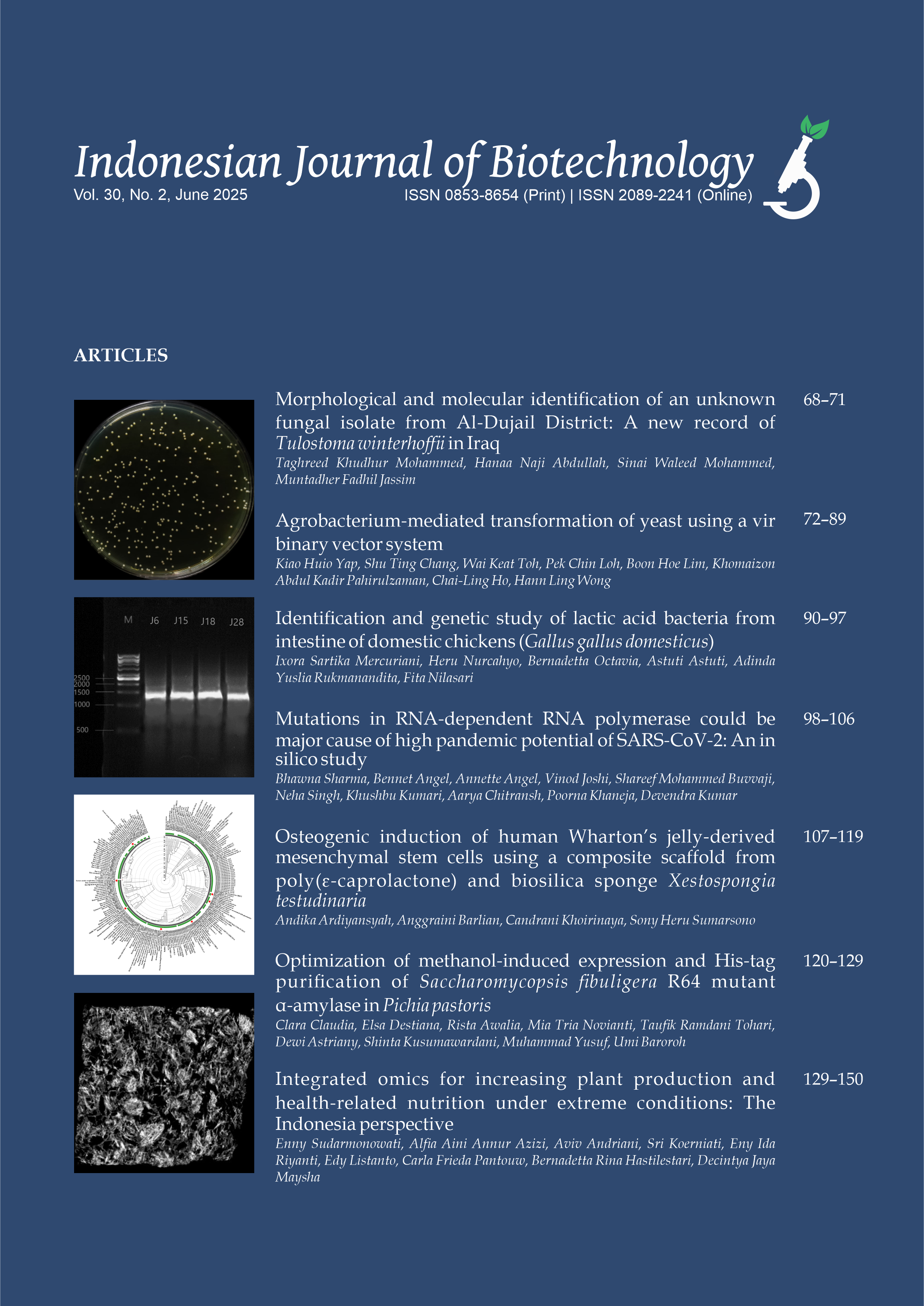Plant growth‐promoting activity of endophytic bacteria from sweet sorghum (Sorghum bicolor (L.) Moench)
Charlie Ester de Fretes(1*), Donny Widianto(2), Yekti Asih Purwestri(3), Tri Rini Nuringtyas(4)
(1) Research Center for Deep Sea, National Research and Innovation Agency, Jl. Y. Syaranamual, Ambon, Maluku, 97123, Indonesia
(2) Research Center for Biotechnology, Universitas Gadjah Mada, Jl. Teknika Utara, Barek, Yogyakarta, 55281, Indonesia; Department of Microbiology, Faculty of Agriculture, Universitas Gadjah Mada, Jl. Flora, Bulaksumur, Yogyakarta, 55281, Indonesia
(3) Research Center for Biotechnology, Universitas Gadjah Mada, Jl. Teknika Utara, Barek, Yogyakarta, 55281, Indonesia; Faculty of Biology, Universitas Gadjah Mada, Jl. Teknika Selatan, Sekip Utara, Yogyakarta, 55281, Indonesia
(4) Research Center for Biotechnology, Universitas Gadjah Mada, Jl. Teknika Utara, Barek, Yogyakarta, 55281, Indonesia; Faculty of Biology, Universitas Gadjah Mada, Jl. Teknika Selatan, Sekip Utara, Yogyakarta, 55281, Indonesia
(*) Corresponding Author
Abstract
Keywords
Full Text:
PDFReferences
Afifi MMI, ElSayed GAM, Manal A, ElGamal H, Massoud ON. 2014. Synergistic effect of biofertilizers containing Nfixer, P and K solubilizers and humic substances on Sorghum bicolor productivity. Middle East J Appl Sci. 4(4):1065–1074.
Afzal I, Shinwari ZK, Sikandar S, Shahzad S. 2019. Plant beneficial endophytic bacteria: Mechanisms, diversity, host range and genetic determinants. Microbiol Res. 221:36–49. doi:10.1016/j.micres.2019.02.001.
Almodares A, Hadi MR. 2009. Production of bioethanol from sweet sorghum: A review. African J Agric Res. 4(9):772–780.
Behera BC, Yadav H, Singh SK, Mishra RR, Sethi BK, Dutta SK, Thatoi HN. 2017. Phosphate solubilization and acid phosphatase activity of Serratia sp. isolated from mangrove soil of Mahanadi river delta, Odisha, India. J Genet Eng Biotechnol. 15(1):169– 178. doi:10.1016/j.jgeb.2017.01.003.
Compant S, Clément C, Sessitsch A. 2010. Plant growthpromoting bacteria in the rhizo and endosphere of plants: Their role, colonization, mechanisms involved and prospects for utilization. Soil Biol Biochem. 42(5):669–678. doi:10.1016/j.soilbio.2009.11.024.
CorreaGaleote D, Bedmar EJ, Arone GJ. 2018. Maize endophytic bacterial diversity as affected by soil cultivation history. Front Microbiol. 9(MAR). doi:10.3389/fmicb.2018.00484.
de Fretes CE, Suryani R, Purwestri YA, Nuringtyas TR, Widianto D. 2018. Diversity of endophytic bacteria in sweet sorghum (Sorghum bicolor (L.) Moench) and their potential for promoting plant growth. Indian J Sci Technol. 11(11):1–10. doi:10.17485/ijst/2018/v11i11/120283.
Duca D, Lorv J, Patten C, Rose D, Glick B. 2014. Microbial indole3acetic acid and plant growth. Anton Van Leeuwenhoek 106:85–125. doi:10.1007/s10482013 0095y.
EkRamos MJ, GomezFlores R, OrozcoFlores AA, RodríguezPadilla C, GonzálezOchoa G, Tamez Guerra P. 2019. Bioactive products from plant endophytic Grampositive bacteria. Front Microbiol. 10(MAR). doi:10.3389/fmicb.2019.00463.
Grönemeyer JL, Burbano CS, Hurek T, ReinholdHurek B. 2012. Isolation and characterization of root associated bacteria from agricultural crops in the Kavango region of Namibia. Plant Soil. 356(12):67–82. doi:10.1007/s1110401107987.
Gupta G, Parihar SS, Ahirwar KN, Snehi SK, Singh V. 2015. Plant Growth Promoting Rhizobacteria (PGPR): Current and Future Prospects for Development of Sustainable Agriculture. J Microb Biochem Technol. 07(02). doi:10.4172/19485948.1000188.
Gusti I, Mas A, Agung S, Ketut Sardiana I, Diara W, Made G, Nurjaya O. 2013. Adaptation, Biomass and Ethanol Yields of Sweet Sorghum (Sorghum bicolor (L.) Moench) Varieties at Dryland Farming Areas of Jimbaran Bali, Indonesia. J Biol Agric Healthc. 3(17):110–115. URL www.iiste.org.
Hallmann J, QuadtHallmann A, Mahaffee WF, Kloepper JW. 1997. Bacterial endophytes in agricultural crops. Can J Microbiol. 43(10):895–914. doi:10.1139/m97 131.
Hardoim PR, van Overbeek LS, van Elsas JD. 2008. Properties of bacterial endophytes and their proposed role in plant growth. Trends Microbiol. 16(10):463–471. doi:10.1016/j.tim.2008.07.008.
Hayat R, Ali S, Amara U, Khalid R, Ahmed I. 2010. Soil beneficial bacteria and their role in plant growth promotion: A review. doi:10.1007/s1321301001171.
Hidayati U, Chaniago IA, Munif A, S, Santosa DA. 2014. Potency of Plant Growth Promoting Endophytic Bacteria from Rubber Plants (Hevea brasiliensis Mull. Arg.). J Agron. 13(3):147–152. doi:10.3923/ja.2014.147.152.
Jasim B, Jimtha John C, Shimil V, Jyothis M, Radhakrishnan EK. 2014a. Studies on the factors modulating indole3acetic acid production in endophytic bacterial isolates from Piper nigrum and molecular analysis of ipdc gene. J Appl Microbiol. 117(3):786–799. doi:10.1111/jam.12569.
Jasim B, Joseph AA, John CJ, Mathew J, Radhakrishnan EK. 2014b. Isolation and characterization of plant growth promoting endophytic bacteria from the rhizome of Zingiber officinale. 3 Biotech. 4(2):197–204. doi:10.1007/s1320501301433.
Mareque C, Taulé C, Beracochea M, Battistoni F. 2015. Isolation, characterization and plant growth promotion effects of putative bacterial endophytes associated with sweet sorghum (Sorghum bicolor (L) Moench). Ann Microbiol. 65(2):1057–1067. doi:10.1007/s1321301409517.
Olanrewaju OS, Glick BR, Babalola OO. 2017. Mechanisms of action of plant growth promoting bacteria. World J Microbiol Biotechnol. 33(11). doi:10.1007/s1127401723649. Pretty J, Bharucha ZP. 2014. Sustainable intensification in agricultural systems. Ann Bot. 114(8):1571–1596. doi:10.1093/aob/mcu205.
Rosenblueth M, MartínezRomero E. 2006. Bacterial endophytes and their interactions with hosts. Mol PlantMicrobe Interact. 19(8):827– 837. doi:10.1094/MPMI190827.
Sansinenea E, Ortiz A. 2011. Secondary metabolites of soil Bacillus spp. Biotechnol Lett. 33(8):1523–1538. doi:10.1007/s1052901106175.
Santoyo G, MorenoHagelsieb G, del Carmen Orozco Mosqueda M, Glick BR. 2016. Plant growth promoting bacterial endophytes. Microbiol Res. 183:92–99. doi:10.1016/j.micres.2015.11.008.
Sun Y, Cheng Z, Glick BR. 2009. The presence of a 1aminocyclopropane1carboxylate (ACC) deaminase deletion mutation alters the physiology of the endophytic plant growthpromoting bacterium Burkholderia phytofirmans PsJN. FEMS Microbiol Lett. 296(1):131–136. doi:10.1111/j.1574 6968.2009.01625.x.
Vendan RT, Yu YJ, Lee SH, Rhee YH. 2010. Diversity of endophytic bacteria in ginseng and their potential for plant growth promotion. J Microbiol. 48(5):559–565. doi:10.1007/s1227501000821.
Xu L, Zhang Y, Read N, Liu S, Friman VP. 2017. Devosia nitraria sp. nov., a novel species isolated from the roots of Nitraria sibirica in China. Antonie van Leeuwenhoek, Int J Gen Mol Microbiol. 110(11):1475–1483. doi:10.1007/s104820170901 z.
Article Metrics
Refbacks
- There are currently no refbacks.
Copyright (c) 2021 The Author(s)

This work is licensed under a Creative Commons Attribution-ShareAlike 4.0 International License.









